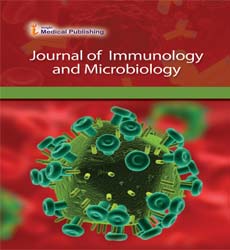Retaining Immunity After Sars-Covid-19
Regina George*
Department of Immunology, University of Stanford, USA
- *Corresponding Author:
- Regina George Department of Immunology, University of Stanford, USA, Email: Regina_007@yahoo.com
Received Date: October 18, 2021; Accepted Date: November 01, 2021; Published Date: November 08, 2021
Citation: Regina G (2021) Retaining Immunity After Sars-Covid-19. J Immunol Microbiol. 5:1.
Commentary
The coronavirus SARS-CoV-2 at the origin of COVID-19 shares further than 70 inheritable similarities with SARS-CoV-1 that was at the origin of 2003 SARS. Infection-associated symptoms are veritably analogous between SARS and COVID-19 conditions and are the same as a community-acquired pneumonia symptom. Antibiotics were empirically given to SARS cases in the early stages of the pathology whereas a different strategy has been decided in the operation of the COVID-19 epidemic with a worldwide arrestment. The cytokine pool, both linked in SARS and COVID-19 severe cases, is generated through inflammation activation, which opens remedial perspectives to offset the pathogenic inflammation. As corticoids have multitudinous side goods that limit their use, fastening on anti-inflammation agents could represent a safer volition for cases with severe COVID-19
After people recover from the COVID-19 virus with a contagion, the immunity system retains a memory of it. Immune cells and proteins that circulate in the body can recognize and kill the pathogen if it’s encountered again, guarding against infection and reducing illness severity. This long-term immunity protection involves several factors. Antibodies such as proteins that circulate in the blood will recognize foreign substances like contagions and neutralize them. Different types of T cells help to recognize and kill pathogens. B cells make new antibodies when the body needs them.
All of these immune system factors have been planted in people who recover from SARS-CoV-2, the viral particle that causes COVID-19. But the details of this immune response and how long it lasts after infection have been unclear. Scattered reports of reinfection with SARS-CoV-2 have raised enterprises that the immune response to the contagion might not be durable. To more understand immunity memory of SARS-CoV-2, experimenters led by an Institute for Immunology anatomized immunity cells and antibodies from nearly 200 people who had been exposed to SARS-CoV-2 and recovered. Time since infection ranged from six days after symptom onset to eight months latterly. Further, 40 patients had been recovered for further than six months before the study began. About 50 people were handed blood samples at further than one time after infection. The exploration was funded in part by NIH’s National Institute of Allergy and Infectious Conditions (NIAID) and National Cancer Institute (NCI). Results were published on January 6, 2021, in Science.
The experimenters' work on durable immunity responses in the maturity of people studied. Antibodies against the shaft protein of SARS-CoV-2, which the contagion uses to get inside cells, were noted in 98 patients one month after symptom onset. As seen in former studies, the number of antibodies ranged extensively between individualities. But, incorrectly, their situations remained fairly stable over time, declining only modestly at 6 to 8 months after infection. Contagion-specific B cells increased over time. People had more memory B cells six months after symptom onset than at one month latterly. Although the number of these cells appeared to reach a table after many months, situations didn’t decline over the period studied. Situations of T cells for the contagion also remained high after infection. Six months after symptom onset, 92 of the patients had CD4 T cells that honored the contagion. These cells help coordinate the immunity response. About half the patients had CD8 T cells, which kill cells that are infected by the contagion. As with antibodies, the figures of different immune cell types varied mainly between individualities. Neither gender nor differences in complaint inflexibility could regard for this variability. Still, 95 of the people had at least 3 out of 5 immunity-system factors that could fete SARS-CoV-2 up to 8 months after infection.
Acknowledgment
The authors are grateful to the journal editor and the anonymous reviewers for their helpful comments and suggestions.
Declaration of Conflicting Interests
The authors declared no potential conflicts of interest for the research, authorship, and/or publication of this article.
Open Access Journals
- Aquaculture & Veterinary Science
- Chemistry & Chemical Sciences
- Clinical Sciences
- Engineering
- General Science
- Genetics & Molecular Biology
- Health Care & Nursing
- Immunology & Microbiology
- Materials Science
- Mathematics & Physics
- Medical Sciences
- Neurology & Psychiatry
- Oncology & Cancer Science
- Pharmaceutical Sciences
